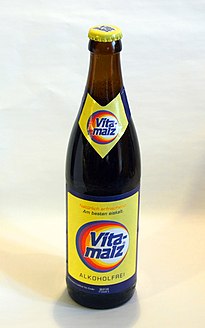
Malt beer is a sweet, low-alcohol beer (0–2.5% ABV[1]) that is brewed like regular beer but with low or minimal fermentation. To keep the alcohol content low, one of two methods may be used: either the yeast is added at about 0 °C (resulting in an alcohol content of under 0.5% ABV) or fermentation is halted at the desired alcohol content (usually in the range of 1 to 2% ABV). It is made from barley malt syrup, sugar, yeast, hops, and water.[2]
Malt beer is considered to be nutritious and is sometimes given to breastfeeding mothers.[3] Among the ancient Egyptians, their form of malt beer (zythum) was considered to work as both a laxative and antidiarrheal; it was considered dangerous, however, for the sick or pregnant to drink it.
In the United Kingdom, Danish malt drinks have become popular amongst the South Asian community and have been sold in their dedicated supermarkets since the 1970s.[citation needed]
After soft drinks, malt beer is one of the most popular beverages sold in Iceland. The two main brands are Egils Maltextrakt (1.2% ABV) and Víking Maltöl (0.9% ABV).[4] Additionally, a seasonal hvítöl is available in the Christmas month (2.2% ABV).[5] The Icelandic malt beer was modelled on the Danish maltøl, which is still brewed by at least one company in Denmark.[6]
In Southern Brazil, with its large communities of German immigrants, a brand called Brahma Malzbier is very popular and it is mainly consumed during the winter months.
In Israel, brands include Nesher Malt, Malt Star and Malti.[7]
Varieties of malt beer are also popular in some Caribbean countries.
West African brands include Guinness Malt, Amstel Malt, Maltex, and Malteni. These are sold as energy drinks.
- ^ "Malzbier". brauherr.de. Retrieved 2013-10-09.
- ^ "Wheat and Rye Malt Use in Brewing Beer". www.beer-brewing.com. Archived from the original on 2013-05-24. Retrieved 2012-03-12.
- ^ "Description of malt beer". Archived from the original on 2016-08-10. Retrieved 2012-03-27.
- ^ "Léttöl getur framkallað ölvunareinkenni" [Light beer may induce intoxication]. Morgunblaðið (in Icelandic). Reykjavik. 3 September 1998. p. 32. Retrieved 7 October 2013.
- ^ "Áfengismagnið í Agli sterka er 4,5%—Aðrir drykkir innihalda 1 til 2,25%" ["Egill sterki" contains 4.5% alcohol—Other beverages between 1 and 2.25%]. Tíminn (in Icelandic). Reykjavik. 3 September 1998. p. 32. Retrieved 7 October 2013.
- ^ "maltøl". Den Store Danske, Gyldendals åbne encyklopædi. February 2009. Retrieved 2013-10-07.
- ^ Rahav, Yehudit (2 November 2004). "מלחמה שחורה: מי ישלוט בשוק הבירות השחורות". ynet (in Hebrew). Retrieved 21 August 2021.